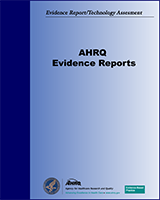NCBI Bookshelf. A service of the National Library of Medicine, National Institutes of Health.
Shekelle P, Morton S, Rich M, et al. Pharmacologic Management of Heart Failure and Left Ventricular Systolic Dysfunction: Effect in Female, Black, and Diabetic Patients, and Cost-Effectiveness. Rockville (MD): Agency for Healthcare Research and Quality (US); 2003 Jul. (Evidence Reports/Technology Assessments, No. 82.)
This publication is provided for historical reference only and the information may be out of date.

Pharmacologic Management of Heart Failure and Left Ventricular Systolic Dysfunction: Effect in Female, Black, and Diabetic Patients, and Cost-Effectiveness.
Show detailsThe meta-analyses have several potential limitations:
- An important limitation, common to many such meta-analyses, is the differential quality of the original studies. We cannot adjust for any inherent biases in the individual studies. However, to mitigate this limitation, we included studies that were double-blind randomized controlled trials and used all-cause mortality as the outcome. These design features help protect against some of the more important biases.
- We restricted attention to the large trials on ACE inhibitors and beta-blockers due to resource constraints. By excluding smaller trials, we may have limited our generalizability and our ability to investigate heterogeneity in treatment effects. We did observe little to no evidence of publication bias among the large trials via visual inspection or formal testing and, given the notable nature of such trials, are fairly confident we did not miss a similar trial in our extensive search.
- Between-study heterogeneity was observed, especially among the ACE inhibitor studies. Although the random-effects model is designed to take this extra variability into account in the estimation of the standard errors and generally widens the confidence interval for the pooled estimate, this model does not explain the heterogeneity. In fact, significant between-study heterogeneity should lead us to interpret a pooled result with caution.
- We conducted a meta-analysis of study summary statistics (relative risks, etc.), rather than a patient-level data analysis due to the fact we could not obtain patient-level data for all trials in a timely and efficient manner. This approach limited us in two ways. First, we were unable to estimate hazard ratios for all subgroups of interest and had to rely on relative risks for some studies. The latter statistic does not adjust for differential followup intervals across studies. Second, we cannot investigate interactions between patient-level characteristics that might mitigate the treatment effect, nor can we adjust for these effects in our estimates. For example, suppose blacks are more likely to have hypertension than whites, and the treatment works less well for patients with hypertension than for those who do not have hypertension. We may conclude that the treatment works less well for blacks than whites when actually if we had controlled for hypertension status, we would not have seen differences between the two racial subgroups. By ignoring the effect of hypertension, we incorrectly attribute its association with treatment to race. A patient-level data analysis would have allowed this adjustment, had data on important confounders been collected.
- Studies did differ in their definition of racial groups. A sensitivity analysis that we conducted to try to determine whether this variability affected our conclusions did not show different results using different definitions.
The cost-effectiveness analyses have several potential limitations:
- We relied on the SOLVD prevention trial to determine the impact of ACE inhibitors on patients with asymptomatic left ventricular dysfunction. Although this is the best data source available, the SOLVD patients were not randomly selected from the population. It is possible that randomly selected patients with reduced left ventricular function may show less benefit with ACE inhibitors.
- Our analysis did not include the potential impact of beta-blockers in the base case, because these agents have not yet been evaluated in randomized trials of asymptomatic patients. If beta-blockers have an incremental benefit over ACE inhibitors in this population, the cost-effectiveness of screening will likely improve, assuming beta-blocker treatment is cost-effective for heart failure patients.
- We limited our analysis of BNP to screening asymptomatic subjects. Our study did not examine the appropriate use of BNP to adjust medications (e.g., dose of diuretics, use of digoxin) for patients with heart failure.
- Our study did not specifically model other tests (biopsy, cardiac catheterization) and treatments (revascularization) that may result from the knowledge of depressed left ventricular function, because there is no accepted standard of care with additional testing or treatments (other than ACE inhibitors and possibly beta-blockers) for asymptomatic patients with reduced ejection fraction. Any additional testing such as screening for coronary artery disease should be evaluated with a separate cost-effectiveness analysis.
- Our cost-effectiveness analysis did not distinguish between patient subgroups. If ACE inhibitors are more or less effective in men or women, the cost-effectiveness of treatment (and screening for depressed ejection fraction) will vary by gender. Additional studies are needed to determine which patient groups have a high enough prevalence of depressed left ventricular function (> 1%) to make screening cost-effective.
- Limitations - Pharmacologic Management of Heart Failure and Left Ventricular Sys...Limitations - Pharmacologic Management of Heart Failure and Left Ventricular Systolic Dysfunction
- Tk1 thymidine kinase 1 [Mus musculus]Tk1 thymidine kinase 1 [Mus musculus]Gene ID:21877Gene
Your browsing activity is empty.
Activity recording is turned off.
See more...